10 Vast.ai Alternatives for GPU Cloud Computing in 2025
By Jess Lulka
Content Marketing Manager
- Updated:
- 19 min read
As demand for affordable, on-demand GPU compute has exploded, Vast.ai has become a popular choice for developers, researchers, and startups looking to rent powerful hardware at competitive prices. Its peer-to-peer marketplace and flexible pricing have made it a go-to for AI training, rendering, and other compute-intensive tasks. But as the GPU ecosystem matures and new providers enter the market, teams are increasingly seeking alternatives that better fit their performance, reliability, or compliance needs.
The GPU market has expanded, and plenty of cloud providers now offer on-demand GPU compute with extra services, integrations, and security.
This article explores Vast.ai’s main uses, some of the concerns surrounding its use, how to evaluate other options, and 10 Vast.ai alternatives to consider for on-demand GPU computing.
Key takeaways
-
Vast.ai is a decentralized GPU marketplace that allows users to automatically access GPU computing power at low prices worldwide.
-
Even with its benefits, there are concerns around security, tooling integrations, environmental separation, and GPU management capabilities.
-
Current Vast.ai alternatives include DigitalOcean, Google Cloud Compute, Runpod, TensorDock, and Coreweave.
Why is Vast.ai so popular?
Vast.ai provides on-demand, affordable GPU rental. It’s widely used by teams that want cost-effective GPUs for their high-performance computing and AI/ML projects. Many organizations use Vast.ai for AI training, fine-tuning, and inference. Vast.ai offers options for GPU cloud, serverless GPUs, and enterprise GPU deployments, along with prebuilt framework templates for PyTorch, NVIDIA CUDA, and TensorFlow. Organizations use it for benefits such as:
-
Low price and billing structure: A main draw to Vast.ai is its price and pay-as-you-go, no commitment requirement. Its ability to access a decentralized network of thousands of GPUs means you can always find the most cost-effective GPU available and don’t need to sign up for a trial or contract to deploy it in your environment. You’re also not tied to a specific vendor and can spin up or tear down workloads as needed.
-
Custom containers: You can deploy containerized workloads using your preferred format instead of vendor-specific standards. This allows you to have more control over your environment and fine-tune containers to fit your AI/ML workloads.
-
Hardware filtering: Vast.ai’s interface allows you to get granular when searching available GPU offerings. You can specify GPU model, disk size, trust level, VRAM, system memory, and bandwidth to get exactly what you need for your workloads instead of dealing with potential tradeoffs.
-
Horizontal scaling capabilities: Vast.ai provides access to thousands of GPUs across a distributed network, which makes it easy to scale as needed for deep learning or large-scale AI experiments and workloads.
Use case comparison: Vast.ai vs. cloud provider platforms
Having access to computing power through a GPU marketplace provides cost and timing benefits—though it might not be suitable for every AI/ML workload. The marketplace can provide competitive hardware pricing, but you’re just paying for the computing power itself without any additional management features or enterprise infrastructure.
Vast.ai is ideal if you and your team need immediate access to GPU computing resources to quickly spin up, run your workloads, and then spin down or completely delete them. With thousands of options, you can find the right GPU for your project and immediately launch into a production environment without needing to bring your own cloud infrastructure or connect to GitHub, GitLab, or other CI/CD tools.
This provides a lot of flexibility when it comes to environment customization and allows you to manually set up the production environment features when it comes to security measures, container deployments, and code builds. With these features in mind, Vast.ai makes the most sense for:
-
Rapid AI/ML experiments
-
Cost-intensive research projects
-
One-off training jobs
Vast.ai alternatives, such as traditional cloud providers, can offer on-demand GPU compute power along with tools and platforms to deploy your AI/ML workloads, manage them, and configure your projects and hardware as needed over the course of a specific project. Cloud provider platforms offer capabilities for virtual private cloud, DevOps tool integration, zone-specific GPU availability, compliance certification, staging and test environments, as well as technical support. This makes using a cloud provider and a GPU cloud platform ideal for:
-
AI/ML applications that require regulation or compliance with industry standards or SLAs
-
Data protection for sensitive or confidential information
-
Specific tools to help with infrastructure deployment or automation
-
Projects that require testing, iteration, and staging before production
How to evaluate Vast.ai alternatives
Vast.ai does provide GPU access, but depending on your AI/ML workloads, what you may really need is a platform that can help you manage your hardware, provide security measures, and integrate with CI/CD tools. Having these capabilities allows you to optimize your infrastructure over time as workload requirements change, automate repetitive tasks such as container deployment, and ensure your data is secure across your infrastructure. When considering alternatives to Vast.ai, here are several factors to consider:
Cost effectiveness and pricing structure
Affordability is a big draw to Vast.ai, so consider how going with a potentially higher cost GPU provider would affect your budget. Most vendors do provide a pay-per-use pricing structure for cloud, virtual, and serverless GPUs, but may require a minimum usage requirement or have additional costs when it comes to data access and storage. Still, even with higher costs than Vast.ai, you might find that this also brings more necessary features for running GPU workloads.
GPU availability
Having a wide variety of GPUs available across different regions and availability zones can help minimize wait times during high-demand periods and make it easier to deal with potential quotas and usage limits. Plus, having different options for GPUs means you can better match your specific AI workloads to the right GPU type to avoid overprovisioning GPU infrastructure or overpaying for computing power that might not be optimized for your workloads.
Security features
Having the right security measures gives you peace of mind when running your code and makes it easier for you and your team to implement necessary compliance requirements for your use cases or industry. Features to look for include encryption, isolated environments, availability in specific regions, meeting SLAs, support for GDPR, services built with HIPAA in mind, alignment with SOC2, and industry-specific certifications.
Framework and tooling integrations
If you’re running AI/ML workloads, you’ll definitely want integrations for frameworks such as PyTorch, TensorFlow, and NVIDIA CUDA to ensure your applications run smoothly and support the required use cases. You’ll also want to make sure you can easily integrate any CI/CD and DevOps tools to help with process automation and reduce manual deployment for containers and serverless workloads.
Technical support
GPUs and AI/ML workloads do come with a learning curve, so you want to make sure your provider has support options to help you troubleshoot when something goes wrong, simply provide answers to technical questions about your projects, or help optimize your environment to make sure everything can run smoothly. Depending on the type of technical support you’d like, you can look for community tutorials, a dedicated support team, ticketed help, or white glove customer service options.
10 Vast.ai alternatives to consider
Even with Vast.ai on the market, a variety of vendors still provide on-demand, scalable GPU computing power for AI/ML workloads and support tooling integrations, reporting capabilities, and technical support. Here’s a look at some GPU cloud providers you can evaluate:
| Vendor | Available GPUs (examples) | Billing model & granularity | Common use cases | Key selling points |
|---|---|---|---|---|
| DigitalOcean | NVIDIA H100, H200, L40S, RTX 4000/6000 Ada; AMD MI300X/MI325X | Usage-based; per-second billing with a 5-minute minimum for GPU Droplets | Inference, fine-tuning, graphics workloads | Simple UX, predictable rates, GPU “Droplets” |
| Amazon EC2 UltraClusters | Clustered GPU instances (P5/P5e/P5en = H100; P4d/P4de = A100) | Usage-based; hourly billing for GPU instances (some EC2 per-second; UltraClusters often hourly) | Exascale-class distributed training, HPC with EFA + FSx for Lustre | Petabit-scale non-blocking network, EFA, several exaflops on demand |
| Baseten | H100 80GB; B200 (inference) | Usage-based; billed per minute for active model serving | Fully-managed model serving & autoscaling inference | Serverless deployments, fractional/MIG H100 options |
| CoreWeave | NVIDIA L40S/L40, H100, H200, B200, A100, RTX 6000, GH200 | Usage-based; billed hourly (on-demand), full hour charged for partial usage | Large-scale training, high-throughput inference, rendering | First-to-market NVIDIA parts, fast provisioning, InfiniBand |
| Corvex | NVIDIA H200, B200 (multi-GPU clusters) | Usage-based; billed hourly (discounts for longer reservations) | Multi-node training with high-speed fabric | HIPAA-aligned US hosting, 3.2 Tb/s IB/ROCE, large HGX/DGX nodes |
| Google Compute Engine | H100 (A3/A3 Mega), A100 (A2), L4 (G2), T4/V100/P100 | Usage-based; per-minute billing (first minute minimum, then rounded up) | Training/inference on GCE VMs | Deep discounts (Spot/CUD/SUD), global regions, A3/A2/G2 families |
| IBM Cloud GPU Server | NVIDIA L40S, A100 PCIe (select regions) | Usage-based; hourly billing for GPU servers (varies by profile/region) | HPC, AI training/inference on IBM VPC/bare metal | Enterprise support, regional profiles, promotional discounts |
| Northflank | H100, H200, A100, B200 (serverless containers & jobs) | Usage-based; hourly rates for containers/jobs | Deploy/scale containers for training & inference; CI/CD built-in | Simple serverless DX, competitive GPU rates, fast spin-up |
| RunPod | H100 80GB, RTX 4090, A6000/RTX 6000 Ada, others | Usage-based; billed per second for pods and serverless endpoints | Pay-as-you-go training, fine-tuning, low-latency inference | On-demand GPUs, serverless deployments, instant clusters |
| TensorDock | Various NVIDIA GPUs (e.g., RTX 3090, A100, H100 depending on sellers) | Usage-based; billed hourly (marketplace-style pricing) | Cost-effective GPU rental for AI/ML, rendering, compute workloads | Peer-to-peer GPU marketplace with flexible rates and availability |
Features and pricing are accurate as of September 30th, 2025, and subject to change.
1. DigitalOcean
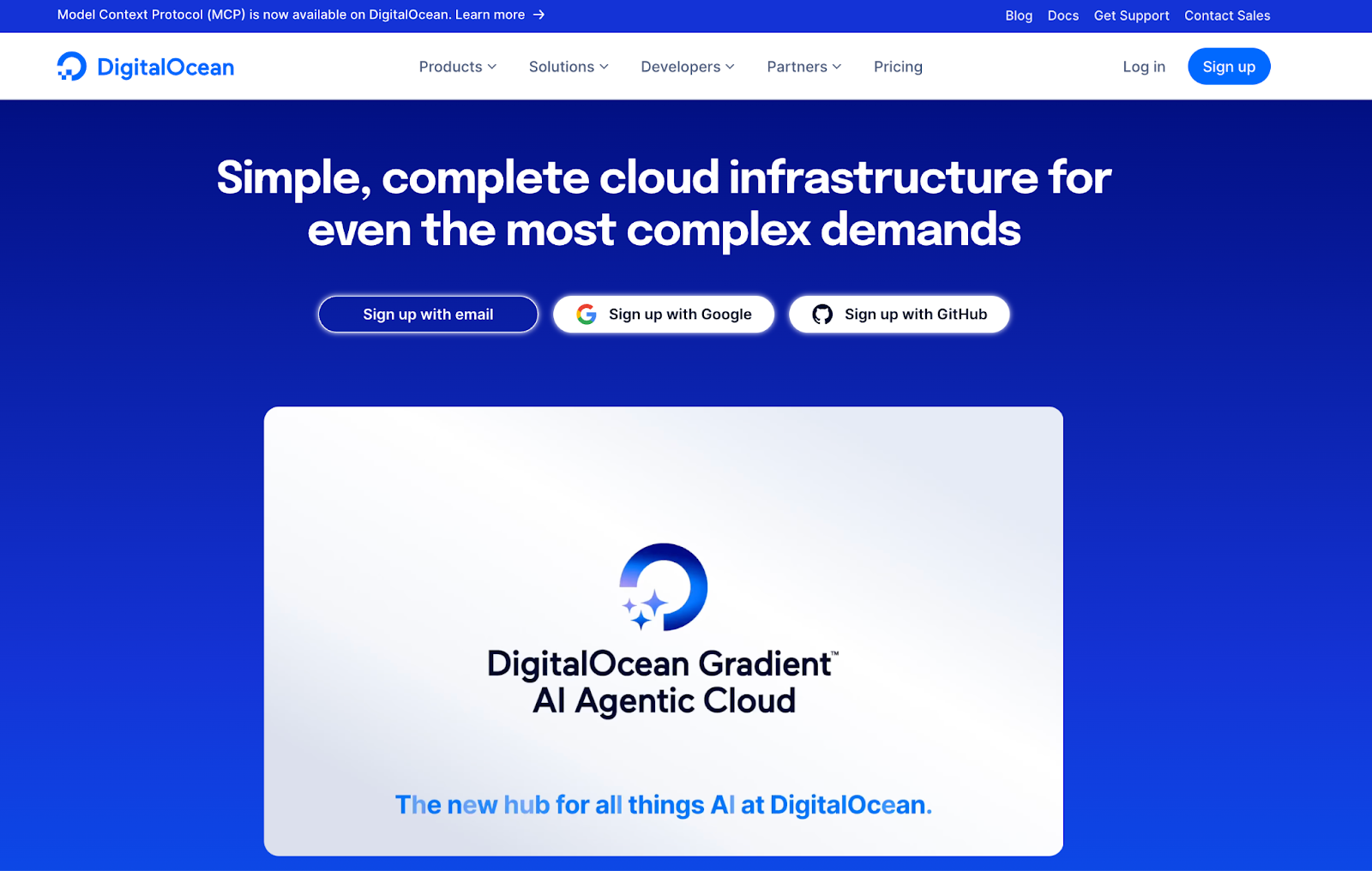
DigitalOcean offers several options for running AI/ML workloads with GPUs: GPU Droplets and Bare Metal GPUs. Droplets offer on-demand GPU computing power to run deep learning, high-performance, or AI/ML workloads that can integrate into your overall infrastructure, automatically scale, and all with transparent pricing. All GPU Droplets have a maximum bandwidth of 10 Gbps public and 25 Gbps private. Bare Metal GPUs are available for more customized AI/ML deployments and give you and your team full access to your hardware environment so you can fine-tune your infrastructure to exactly support your computing needs. DigitalOcean’s offerings also support open source AI/ML frameworks, Kubernetes, as well as serverless GPU options with the DigitalOcean GradientTM AI Agentic Cloud.
Key features:
-
Support for both static and dynamic workflow types with the ability to scale Droplets up to 8 GPUs per instance.
-
Bare metal instances offer dedicated, single-tenant infrastructure with full hardware control.
-
Compatibility with open source standards and frameworks, including PyTorch and TensorFlow.
Available GPUs: NVIDIA H100, H200, RTX 4000 Ada Generation, RTX 6000 Ada Generation, L40S, AMD Instinct MI300X, MI325X
Pricing: GPU Droplets: Starting at $0.76/GPU/hr; custom pricing for Bare Metal deployments
2. Amazon EC2 Ultraclusters
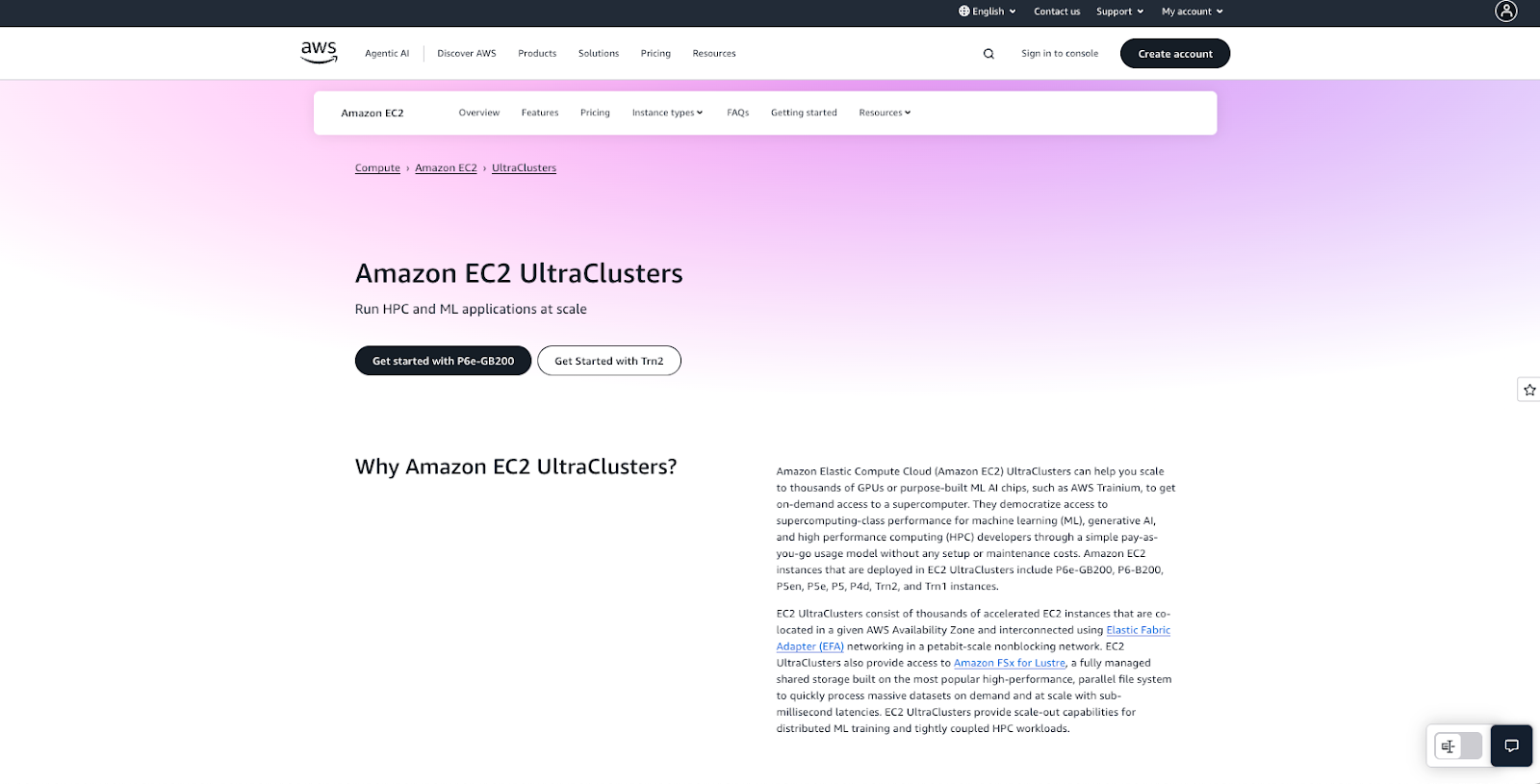
Amazon EC2 Ultraclusters offer on-demand computing server access and are suited for high-performance workloads, including large-scale machine learning training, generative AI tasks, and high-performance computing applications. It offers integrated storage solutions (Amazon FSx for Lustre) that can support sub-millisecond latencies, high-performance networking through its Elastic Fabric Adapter for high-throughput and low-bandwidth, as well as support for large-scale scalability for even the most demanding ML and HPC workloads.
Key features:
-
High-performance networking that provides a petabit-scale nonblocking networking with speeds of up to 28.8/TBps.
-
Access to thousands of GPUs or purpose-built ML AI chips, including AWS Trainium.
-
High-performance storage through FSx for Lustre that offers up to 1200 Gbps per-client throughput via Elastic Fabric Adapter and NVIDIA GPUDirect Storage.
Available GPUs: NVIDIA GB200 NVL72, Blackwell, H200, H100, A100
Pricing: Pay-as-you-go, charge per hour
3. Baseten
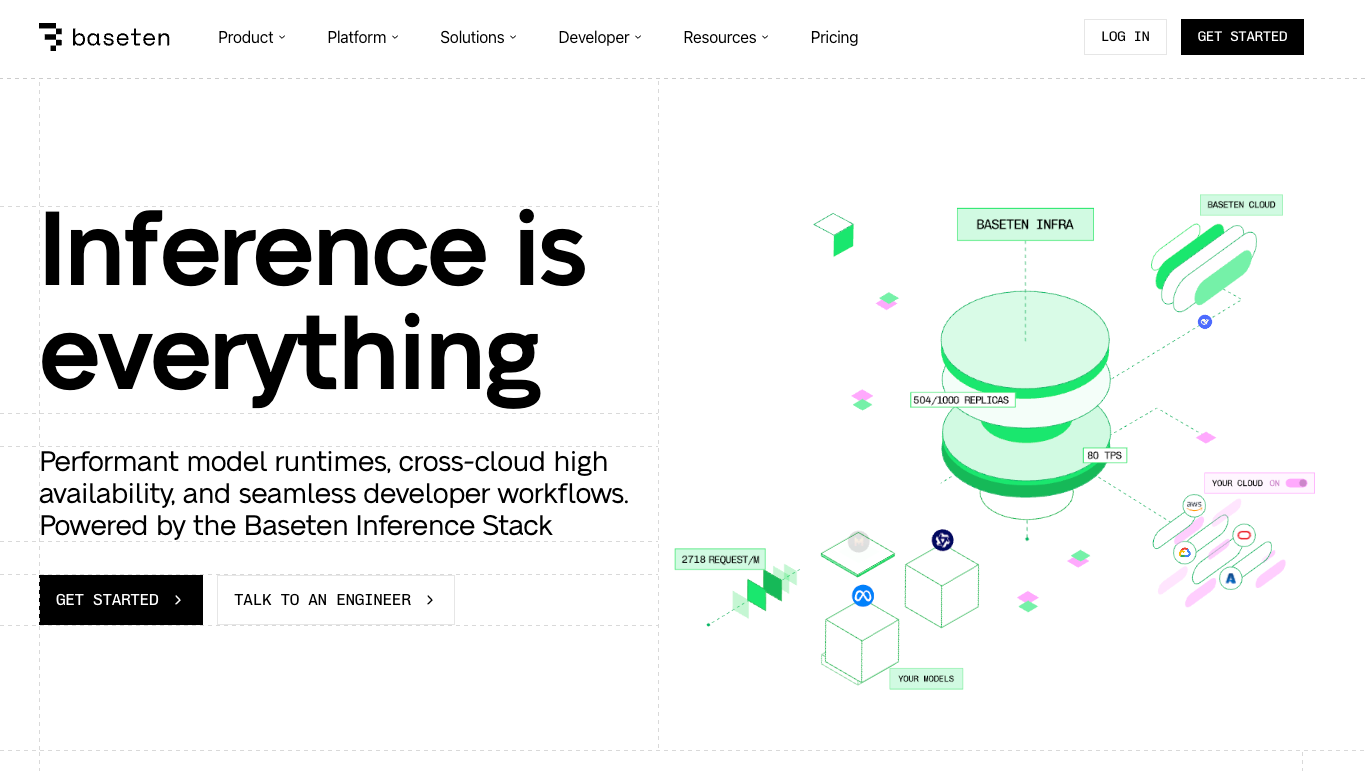
Baseten offers serverless GPU power for model serving and AI inference workloads. Its cloud-native infrastructure allows you and your team to scale workloads across any region with any cloud of your choice. As a serverless GPU provider, you can customize your deployments with Baseten’s framework Truss and run models on your selected GPUs without needing to manage any of the underlying infrastructure over time. The company also offers support for AI model optimization and scaling to ensure your GPUS can properly support your workloads over time.
Key features:
-
Environments for controlled versioning and rollouts with support for scale-to-zero, canary deploys, and structured model management.
-
Inference for synchronous, asynchronous, and streaming predictions with controls to optimize for latency, throughput, or cost.
-
Available metrics for GPU usage, memory, and capabilities to export observability data to Datadog or Prometheus.
Available GPUs: NVIDIA T4, A10G, L4, A100, H100, and B200
Pricing: Usage-based with per-minute pricing
4. CoreWeave
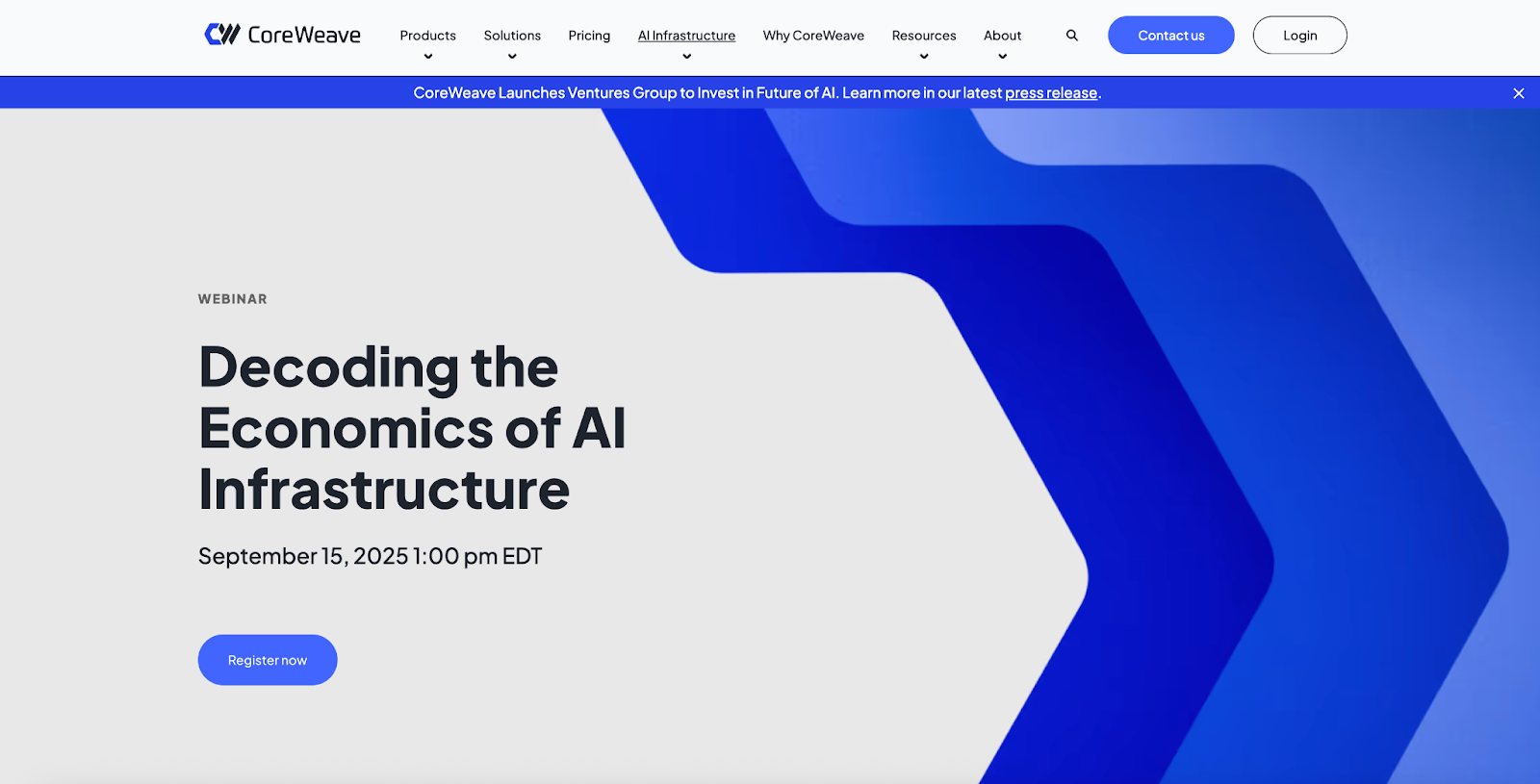
CoreWeave’s portfolio offers a variety of NVIDIA GPUs to support compute-intensive workloads, including AI model training, machine learning, visual effects rendering, and scientific simulations. The company can also work to provide tailored offerings for specific industries such as research, finance, and entertainment, which can be valuable if you’re looking for a technology partner that can help reduce overall time to market and provide the necessary infrastructure. CoreWeave also offers customizable virtual machines and bare metal servers, managed Kubernetes, and high-performance storage to meet access and latency requirements for data-intensive applications.
Key features:
-
Access to tens of thousands of NVIDIA Blackwell systems in a single site with 100K+ GPU megaclusters.
-
CoreWeave’s Mission Control provides automated health checks and node lifecycle management to help increase overall resiliency and ensure GPU node health.
-
Access to SHARP-enabled InfiniBand networking that provides up to 3200 Gbps of one-to-one non-blocking interconnect and sub-millisecond latency.
Available GPUs: NVIDIA GB200 NVL72, HGX B200, HGX H100, HGX H200, HGX A100, L40, L40S, A40, RTX
Pricing: Pay-per-use with per-hour pricing
5. Corvex.ai
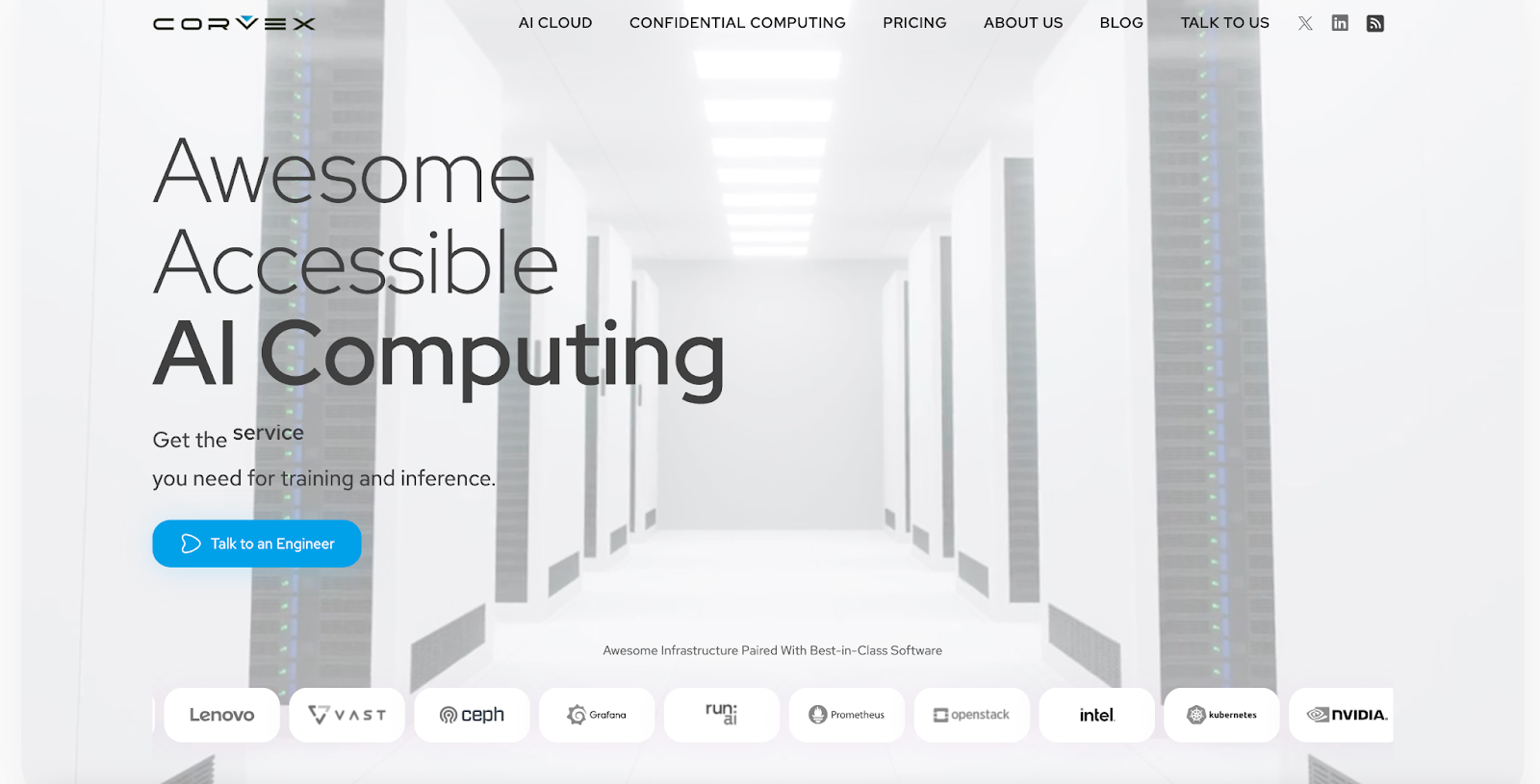
Corvex.ai’s AI cloud is designed to run generative AI models and massive scientific research models and support large language model training. With its dedicated AI supercomputers, it can support use cases in industries such as finance, healthcare, media, and research. GPU offerings can easily scale up to include 72 NVIDIA GB200 NVL72 GPUs for robust AI computing power. It also offers end-to-end SOC 2 certifications for its data centers and cloud GPU offering. This includes firewalls, encryption, access controls, and regular audits.
Key features:
-
Use of NVIDIA Quantum-2 InfiniBand networking that offers up to 3200 Gbps of aggregate bandwidth between each cluster node.
-
End-to-end SOC 2 compliant with enterprise-grade security, including trusted execution environments and encrypted memory.
-
Scalable clusters that can be configured as bare metal, Kubernetes, VMs, or model hosting.
Available GPUs: NVIDIA GB200 NVL72, B200, H200
Pricing: Pay-per-use with per-hour pricing
6. Google Compute Engine
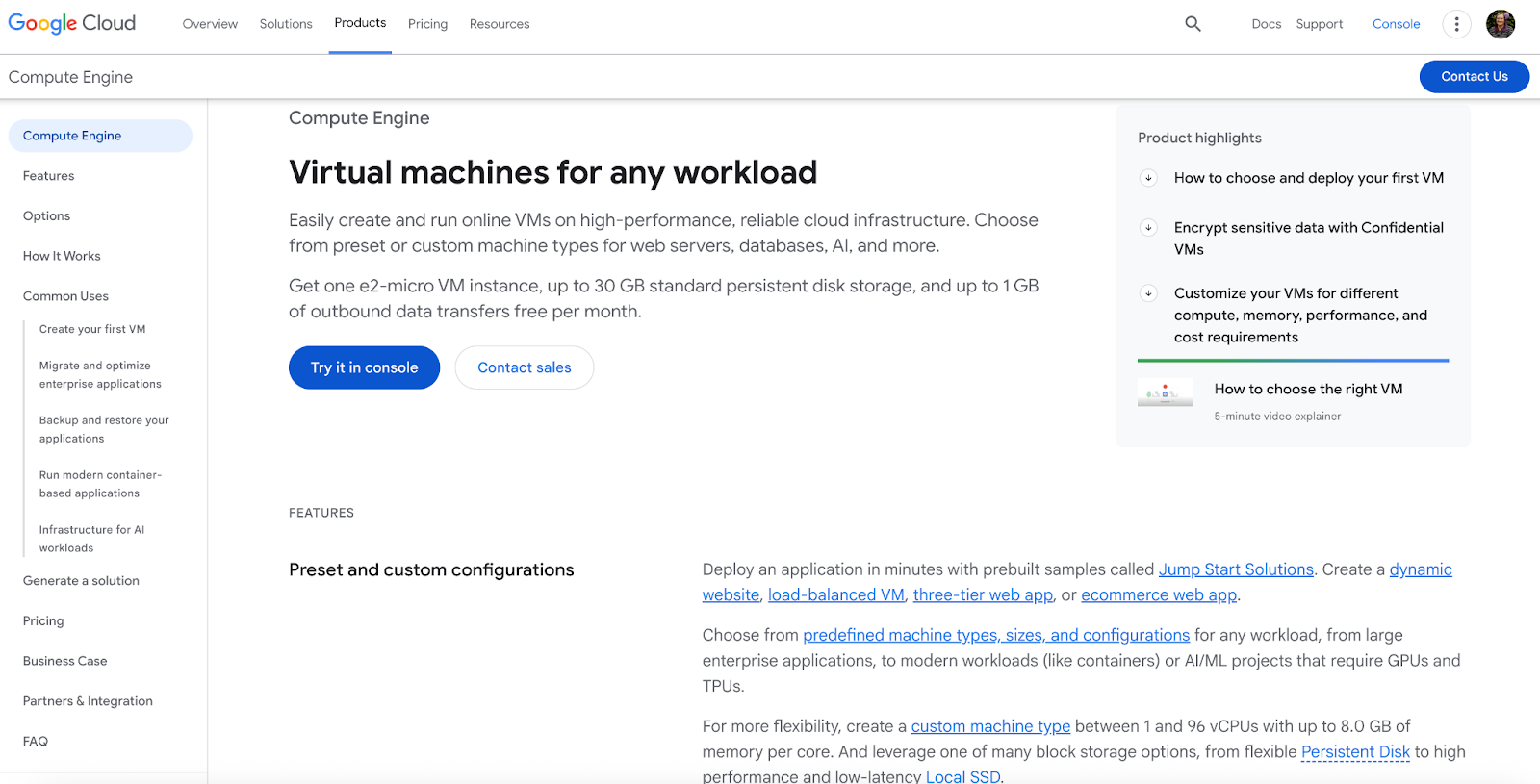
Google Compute Engine gives you and your teams a variety of GPUs and configurations to create scalable infrastructure for your AI/ML workloads. It also has automatic integrations with Google Cloud services, making it easy to integrate with Cloud Run for serverless GPU instances and Google tooling for Kubernetes, managed databases, storage, networking, and analytics. You can configure up to 8 GPUs per instance for your individual workloads and configure the processor, memory, and disk to match whatever computing requirements you have for your AI/ML workloads.
Key features:
-
Managed instance groups that can either automatically add VMs during peak loads or replace underperforming instances.
-
Ability to choose from pre-defined machine types and configurations, or create a custom machine type between 1 and 96 vGPUs and up to 8 GB of memory per core.
-
Flexibility to run your preferred OS, including Debian, CentOS Stream, Fedora CoreOS, Red Hat Enterprise Linux, SUSE, Ubuntu, Windows Server, or FreeBSD.
Available GPUs: NVIDIA GB200, B200, H200, L4, P100, P4, T4, V100, A100
Pricing: Pay-per-use with per-second pricing
7. IBM Cloud GPU Server
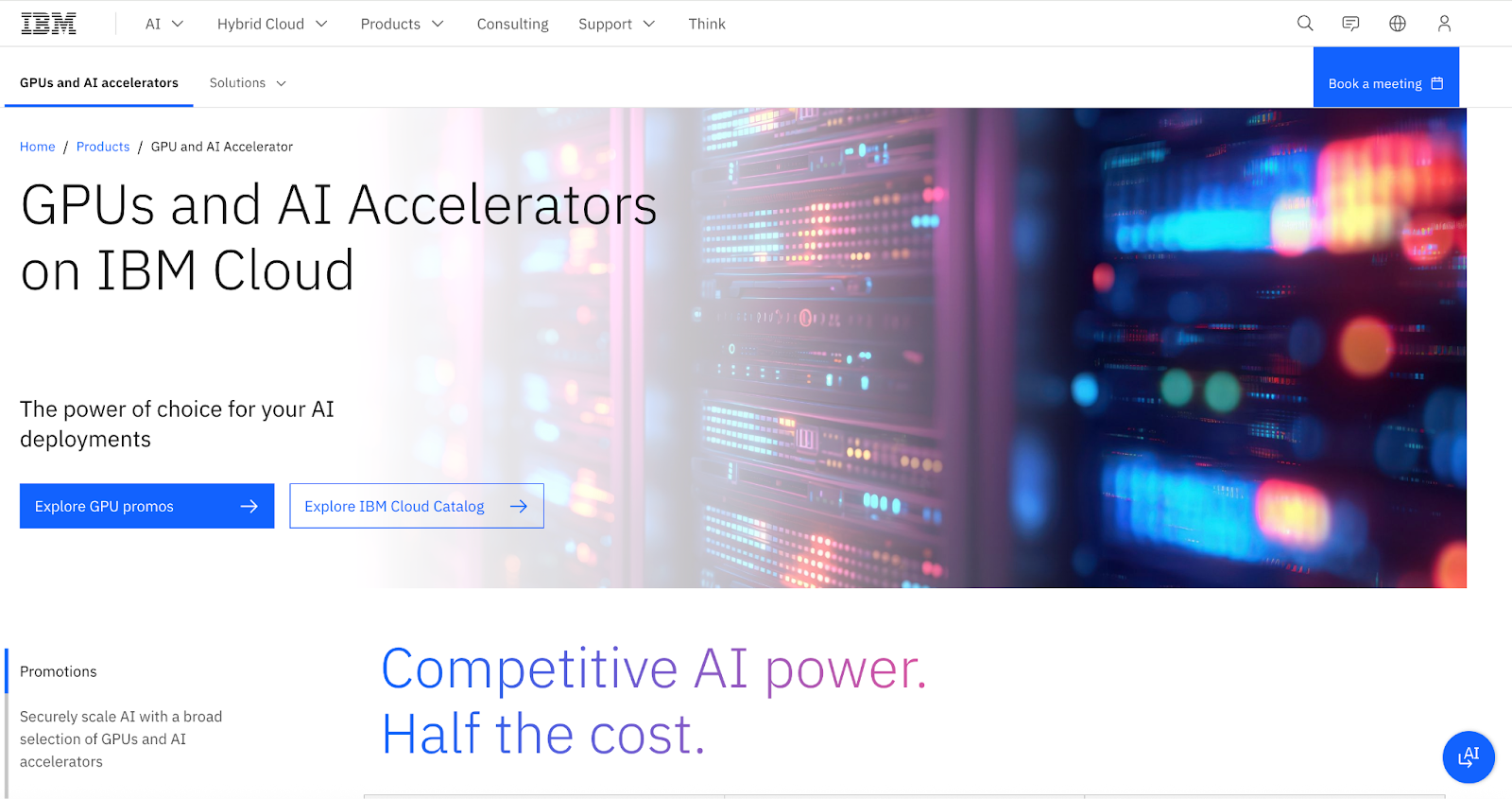
IBM’s Cloud GPU Server offers both bare metal and virtual GPU configurations for organizations in finance, medical imaging, research, and media to get the infrastructure to support intensive applications, scalability, and customization based on workload requirements. IBM offers built-in security monitoring, integration with DevOps tools from Red Hat and IBM, data privacy encryption, and the ability to deploy your AI workloads in the cloud, on-premise, or to edge devices. You can also deploy IBM Gaudi 3 AI accelerators for scaling AI inference applications.
Key Features:
-
Open architecture support for Red Hat OpenShift, IBM watsonx, and HPC software.
-
Support for virtual private cloud, bare metal, and hybrid environments.
-
AI accelerator chips that offer high-memory bandwidth (3.7 Tbps bandwidth) and high-capacity data transmission (24x 200 GbE ports).
Available GPUs: NVIDIA H100, H22, A100, L40S, L4, V100, AMD Instinct MI300X
Pricing: Pay-as-you-go with per-hour pricing
8. Northflank
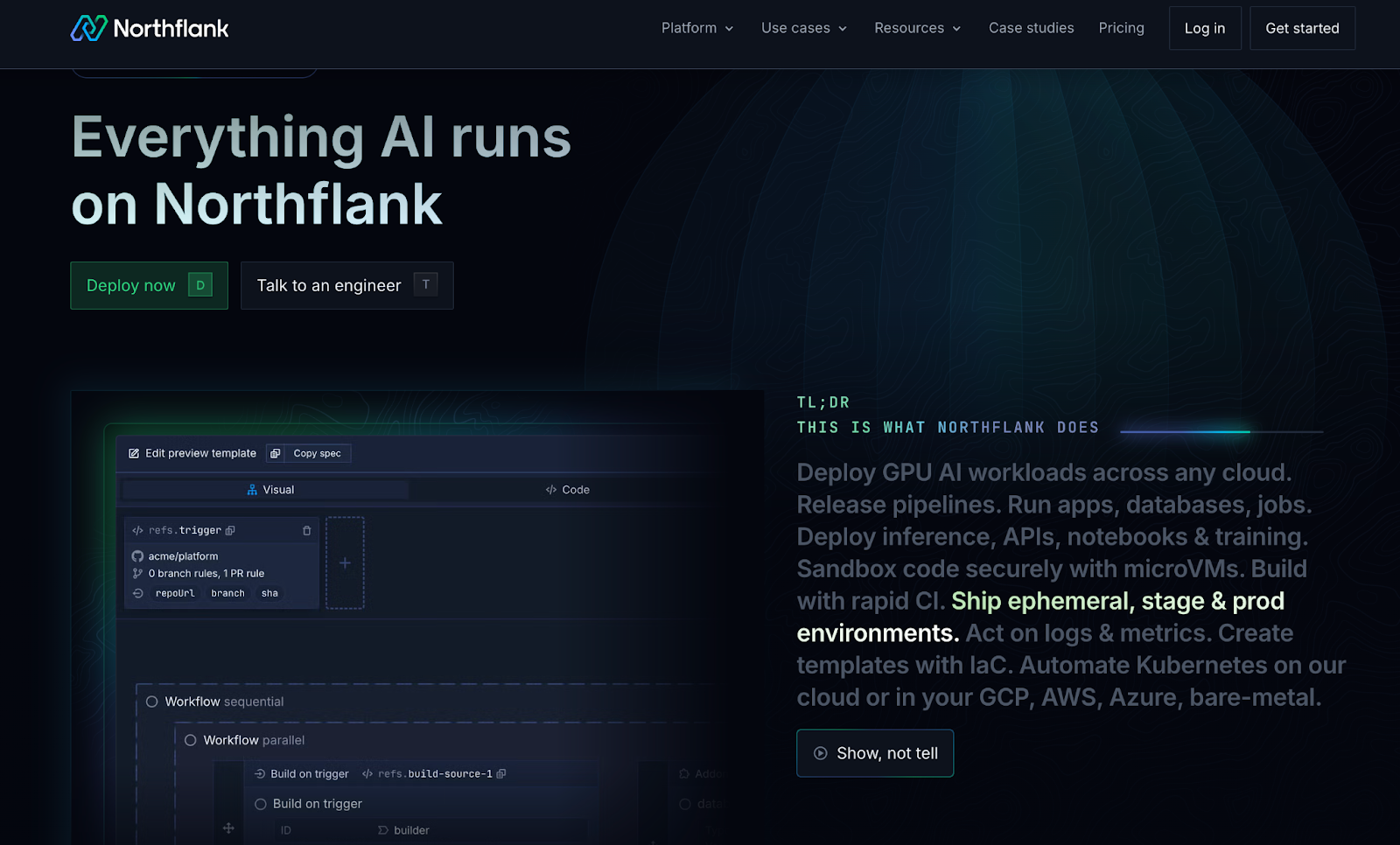
Northflank gives you a platform to deploy and scale your AI applications. Optimized for latency-sensitive workloads, you can use it to deploy large language models, fine-tuning, inference APIs, and the Ray compute engine. It also allows you to bring your own cloud, Docker images, have full runtime control with no vendor lock-in, and use its GPU services with autoscaling to match your processing requirements in real-time. You can use its Git-based CI/CD tools, preview environments to test your workloads, and automate your container workloads.
Key features:
-
Automatic load balancing and autoscaling that support adding more GPUs based on CPU and memory usage thresholds.
-
Multi-cloud support for AWS, Azure, Civo, and Google Cloud Platform.
-
Support for timeslicing on provisioned GPUs and multi-instance GPUs.
Available GPUs: NVIDIA T4, L4, A100, H100, H200, L40S, B200, M60, P100, A10G, AMD Instinct MI300X
Pricing: Pay-as-you-go with pricing varying per configuration
9. Runpod
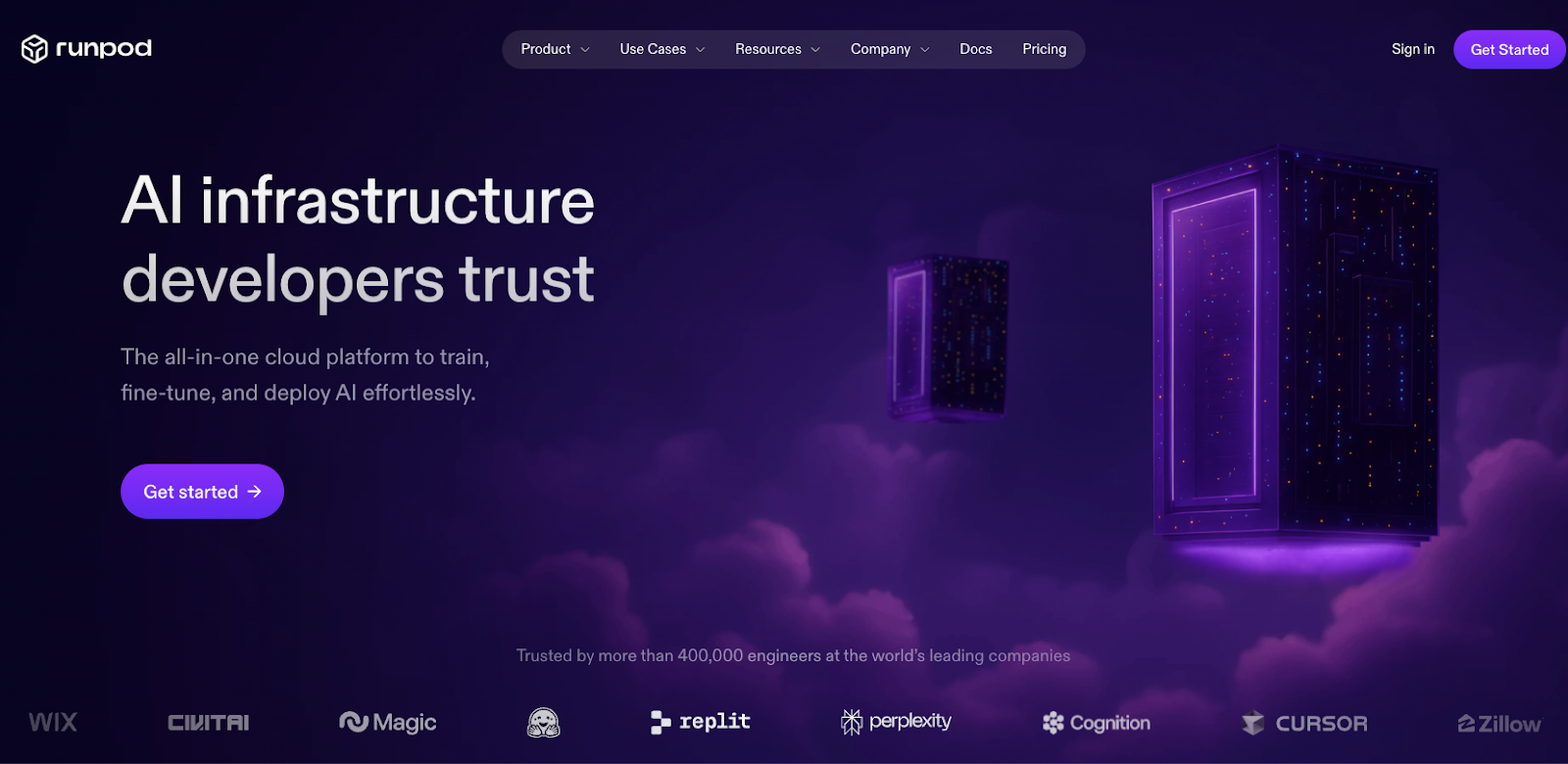
Runpod’s cloud offering provides GPU resources for AI and machine learning workloads. You can access over 50 templates for AI frameworks like PyTorch and TensorFlow, which reduces overall configuration time and lets you deploy your AI applications faster. It also offers serverless computing that lets you access GPU computing power without any infrastructure management requirements. With a variety of NVIDIA GPU offerings, you can take the time to select what hardware works for you and your AI/ML workloads.
Key features:
-
GPUs are available across 32 regions and are ready to deploy in under a minute.
-
Persistent and temporary storage is available without ingress/egress fees.
-
Full API access, connections to CLI and SDKs, and integration with GitHub and CI/CD tools for code automation and deployment.
Available GPUs: NVIDIA H100, H200, B200, L40S, RTX 4000, RTX 2000
Pricing: Pay-as-you-go with per-second pricing
10. TensorDock
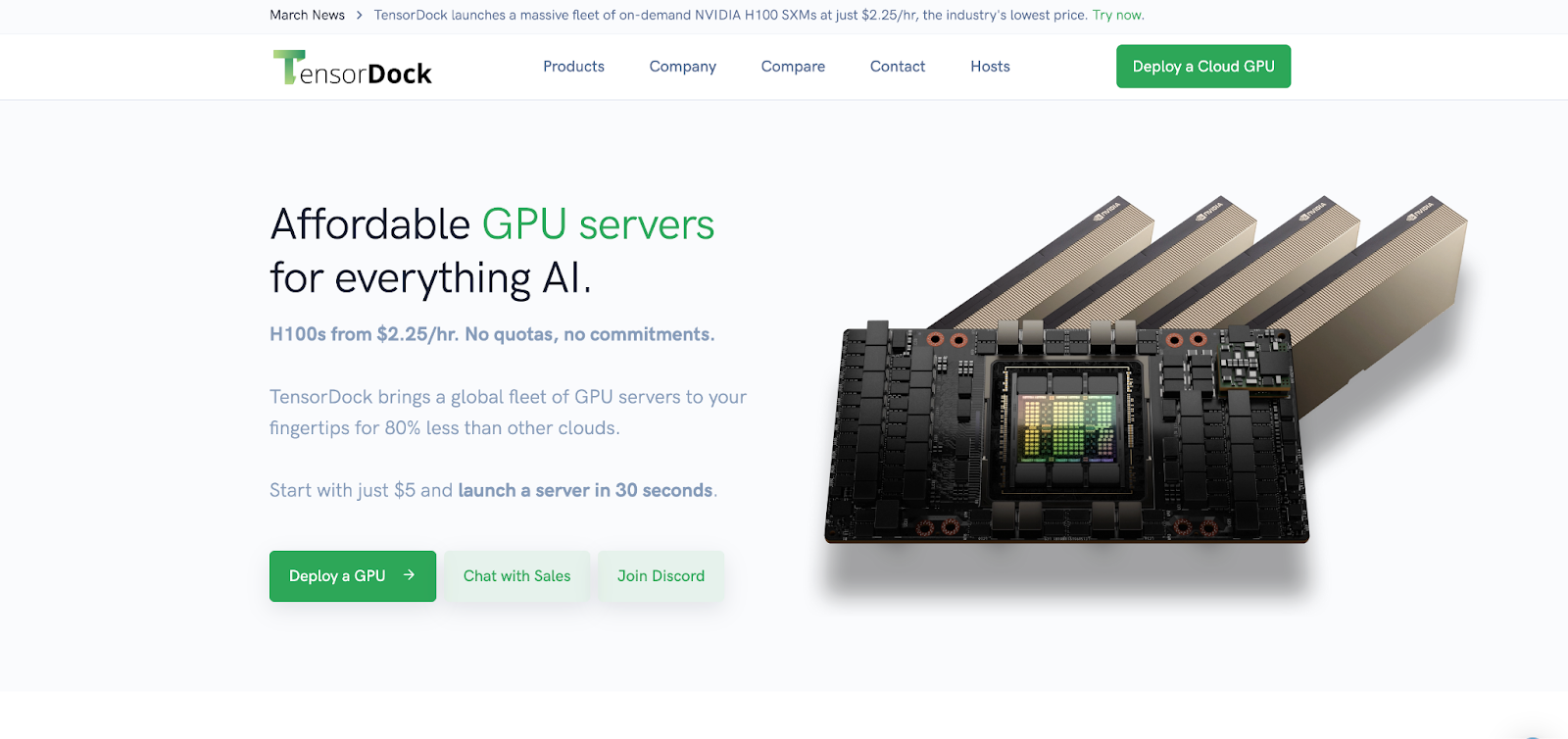
TensorDock is a GPU marketplace that allows you to access up to 30,000 GPUs through its partners, with over 100 data center locations in 20 countries. Its GPU cloud offering can support AI, deep learning, and rendering workloads without any waitlist or quotas. Similar to Vast.ai, TensorDock does not require you to have any sort of contract or minimum GPU usage. It also provides restricted host node access and revoked SSH access within its data centers. TensorDock’s GPUs also provide root access for full OS and driver control, as well as Docker on all virtual machine templates.
Key features:
-
Marketplace model with access to 100 Tier 3 and Tier 4 data centers worldwide.
-
Core GPU Cloud provides 3x replicated storage and 10 Gbps networking speeds.
-
Docker integration, REST API and CLI, and flexible VMs that provide varying levels of control depending on your customization needs.
Available GPUs: Access to over 45 GPU types, top ones include NVIDIA H100 SXM5, A100 SXM4, RTX 4090
Pricing: Pay-as-you-go with per-hour pricing
Resources
H100 vs Other GPUs Choosing the Right GPU for your machine learning workload
Fine-Tuning LLMs on a Budget: Using DigitalOcean GPU Droplets
GPU Performance Optimization for Deep Learning
Vast.ai alternatives FAQs
What is the best Vast.ai alternative in 2025?
The best alternative depends on your AI/ML workload requirements, but options include DigitalOcean, Google Compute Engine, Runpod, and Coreweave. The choice you make will depend on your AI workload requirements, use cases, budget, and GPU availability.
Can I train large AI models on Vast.ai alternatives?
Yes, most Vast.ai alternatives are designed to support AI model training, inference, machine learning workloads, and many other AI use cases. However, how large your model is might affect overall performance, time, and cost, depending on the specific provider.
Do Vast.ai competitors offer enterprise-grade support?
It can depend on the cloud provider, but there are many Vast.ai competitors that offer enterprise-grade support, including DigitalOcean, Northflank, AWS, and Google Cloud. These options cover things such as available AI tokens, job prioritiziation, expanded GPU quotas, and direct technical support.
Accelerate your AI projects with DigitalOcean Gradient GPU Droplets
Accelerate your AI/ML, deep learning, high-performance computing, and data analytics tasks with DigitalOcean Gradient GPU Droplets. Scale on demand, manage costs, and deliver actionable insights with ease. Zero to GPU in just 2 clicks with simple, powerful virtual machines designed for developers, startups, and innovators who need high-performance computing without complexity.
Key features:
-
Powered by NVIDIA H100, H200, RTX 6000 Ada, L40S, and AMD MI300X GPUs
-
Save up to 75% vs. hyperscalers for the same on-demand GPUs
-
Flexible configurations from single-GPU to 8-GPU setups
-
Pre-installed Python and Deep Learning software packages
-
High-performance local boot and scratch disks included
-
HIPAA-eligible and SOC 2 compliant with enterprise-grade SLAs
Sign up today and unlock the possibilities of DigitalOcean Gradient GPU Droplets. For custom solutions, larger GPU allocations, or reserved instances, contact our sales team to learn how DigitalOcean can power your most demanding AI/ML workloads.
About the author
Jess Lulka is a Content Marketing Manager at DigitalOcean. She has over 10 years of B2B technical content experience and has written about observability, data centers, IoT, server virtualization, and design engineering. Before DigitalOcean, she worked at Chronosphere, Informa TechTarget, and Digital Engineering. She is based in Seattle and enjoys pub trivia, travel, and reading.
- Table of contents
Get started for free
Sign up and get $200 in credit for your first 60 days with DigitalOcean.*
*This promotional offer applies to new accounts only.